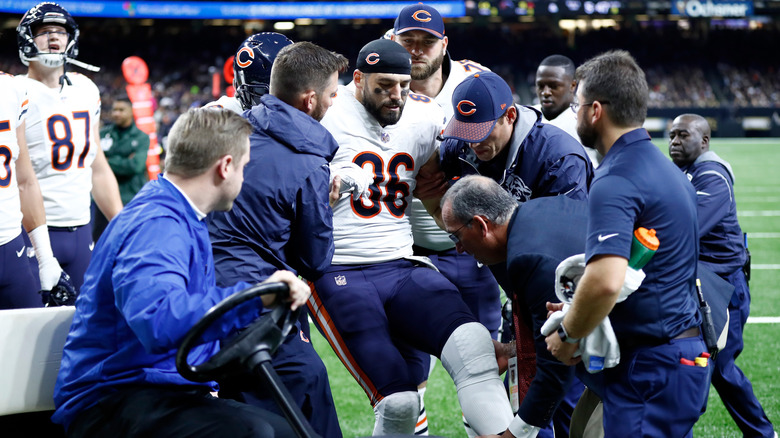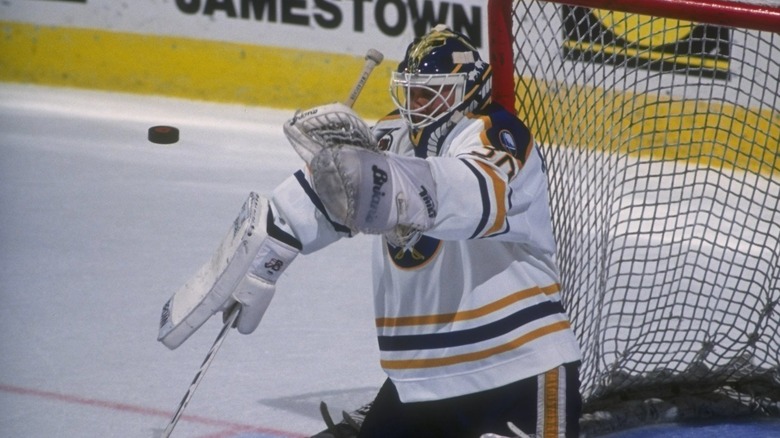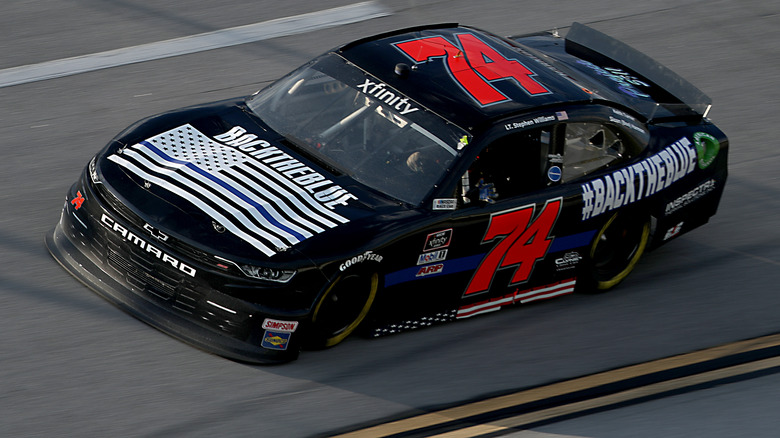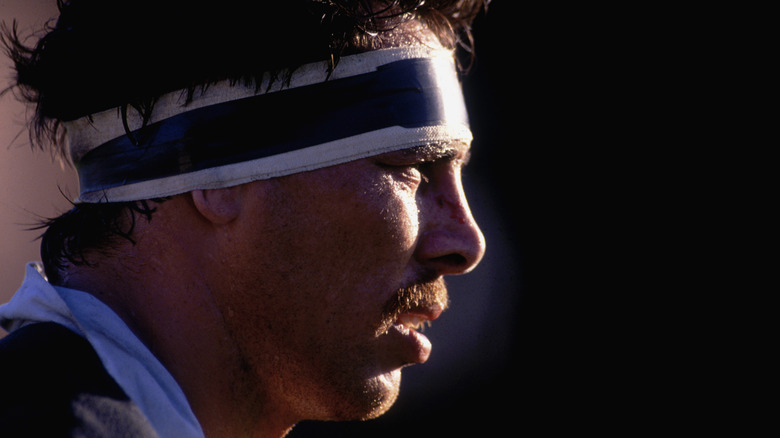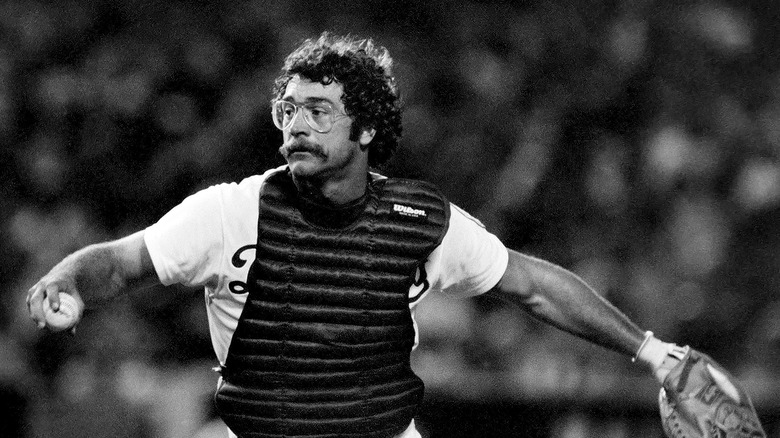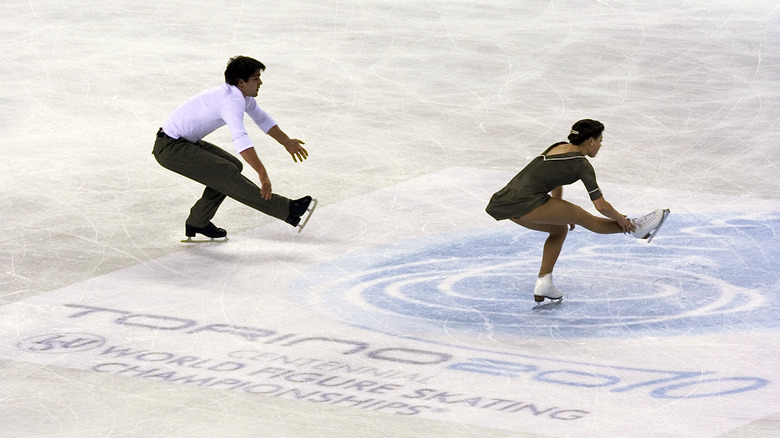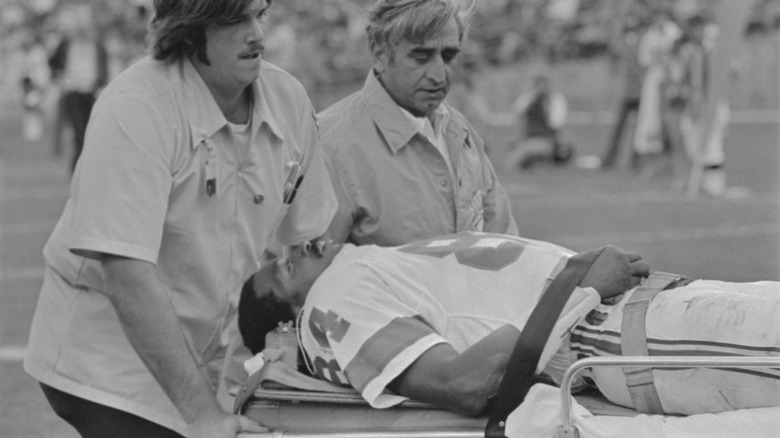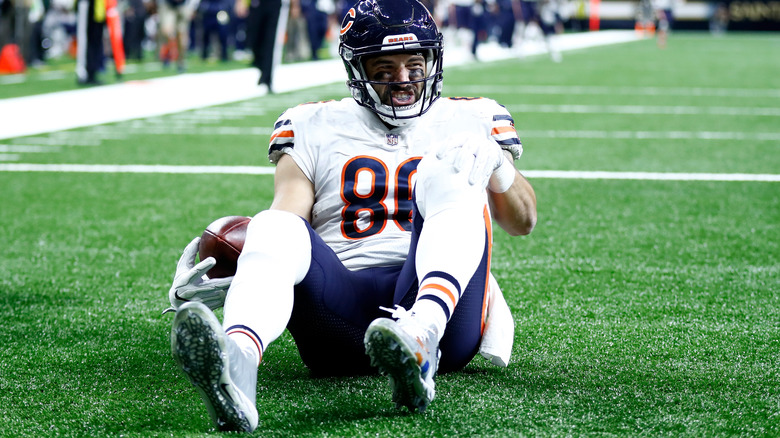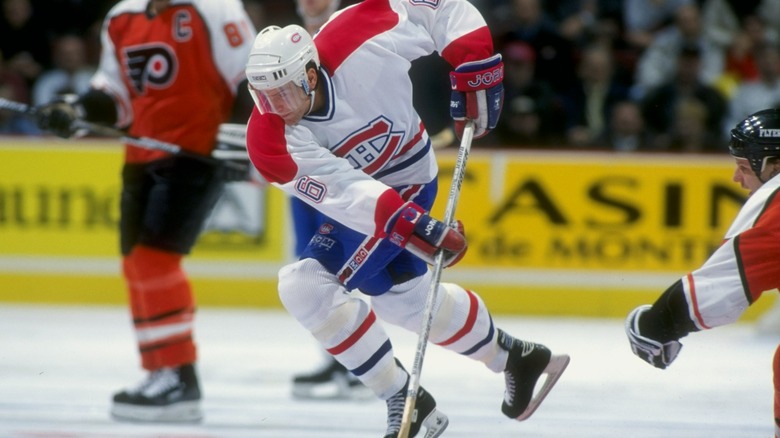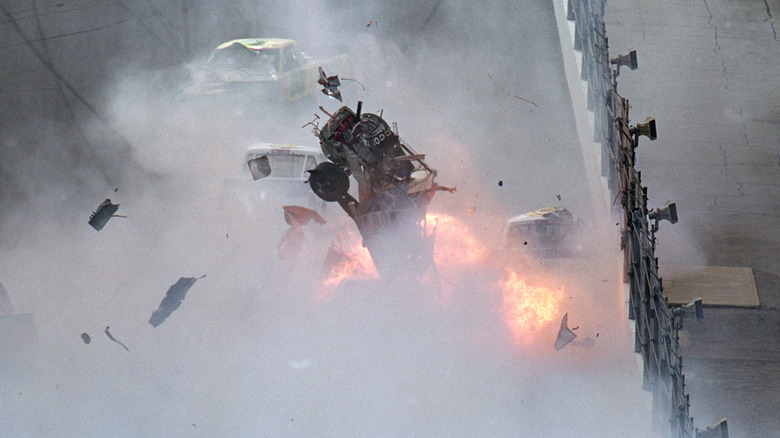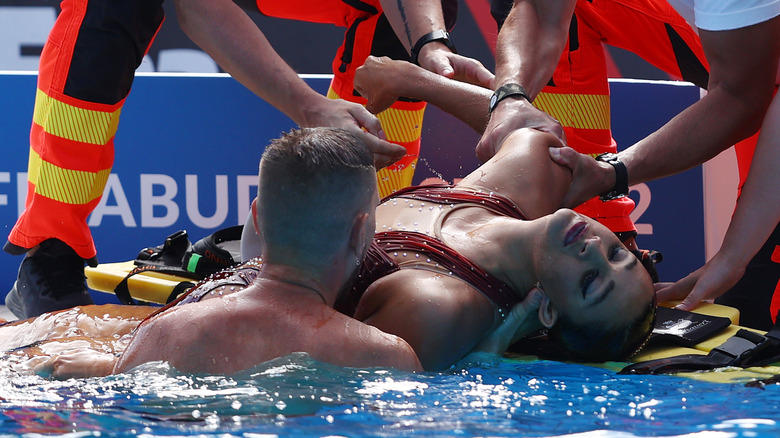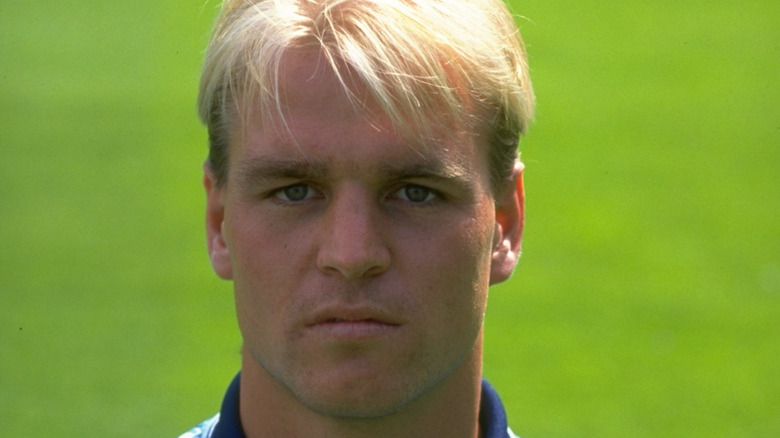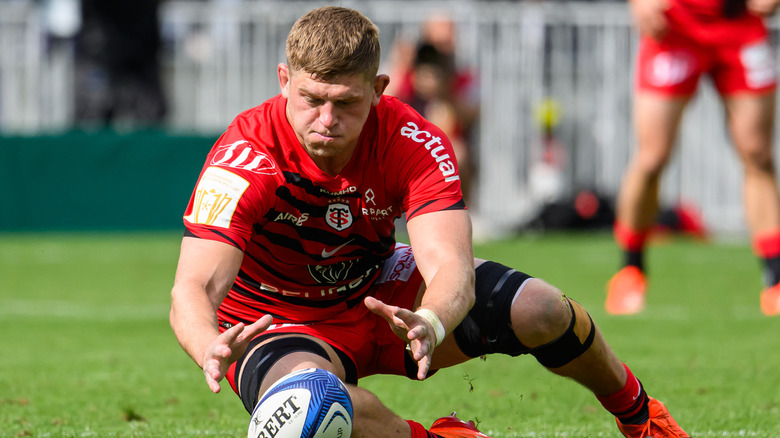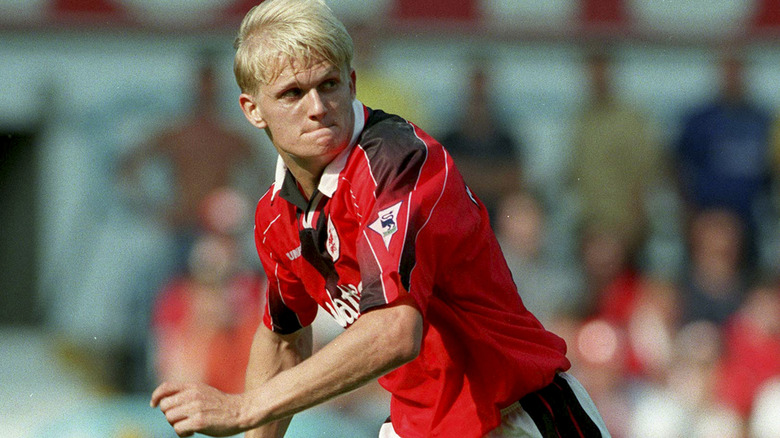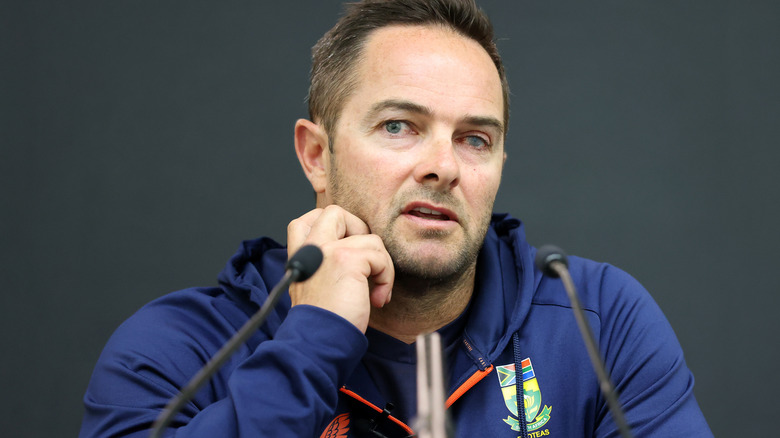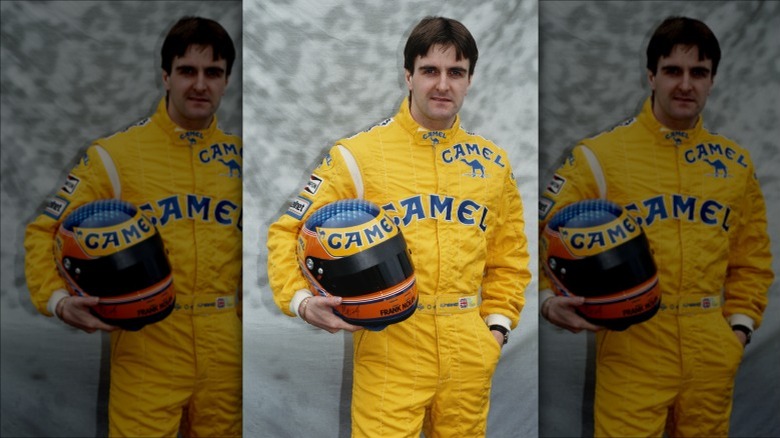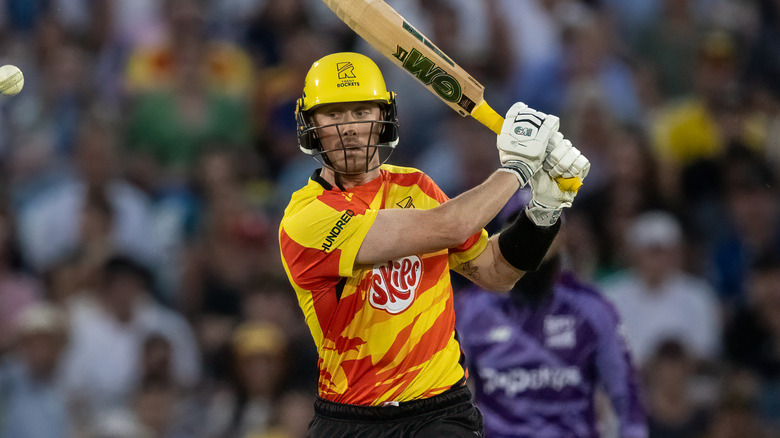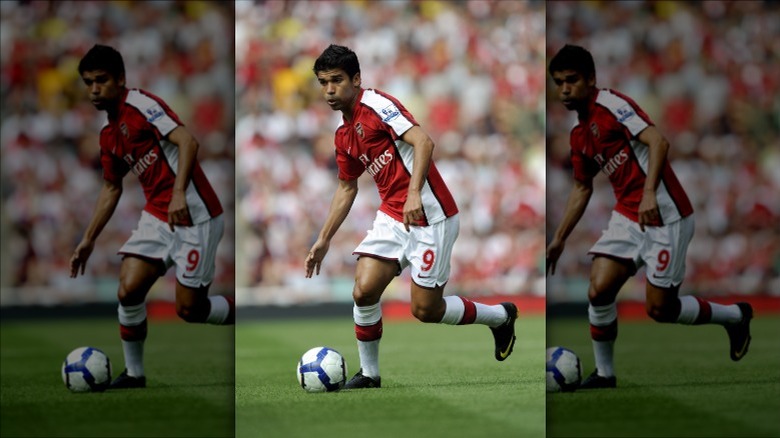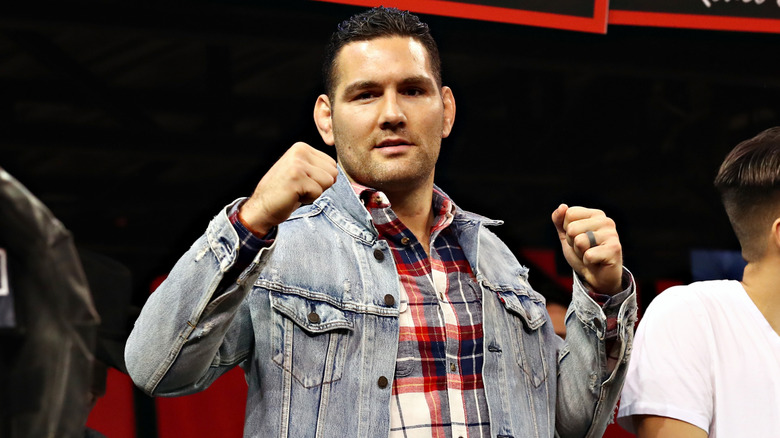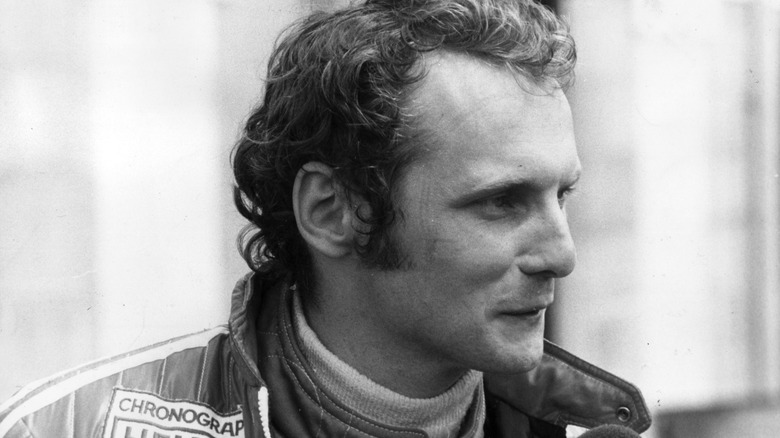The Most Devastating Sports Accidents In History
Injuries are just a natural part of sports. If you've ever played one, even if it was just street hockey as a kid, you know that they're almost inevitable. Yes, they stink — both for the athlete and for the fans — but when men and women are competing at the highest speeds and levels, accidents are bound to happen. And when they do, injuries are bound to occur.
Some injuries are fairly minor, taking players out of the game for just a few days, maybe even a few weeks. But some sports injuries are so traumatic that they can change the course of the athlete's career. There are injuries so horrific that it's hard to believe the athlete managed to survive at all. Here's a look at some of the worst sports accidents that athletes miraculously survived. Warning: Some of these are not for the faint of heart!
Clint Malarchuk
Goalie Clint Malarchuk played in the NHL for 11 seasons and has coached for several major and minor league teams. But despite everything else he has done in the sport, he will always be best known for surviving one of the most horrifying sports accidents ever aired on television. It happened on March 22, 1989. Malarchuk was in net for the Buffalo Sabres when St. Louis Blues player Steve Tuttle crashed into him. Tuttle's skate flipped up and slashed Malarchuk's throat wide open, severing his carotid artery.
Malarchuk collapsed and was only saved by the quick thinking of the team trainer, Jim Pizzutelli, who happened to be a former Army medic who had served in the Vietnam War. Drawing on his combat experience, Pizzutelli managed to stabilize Malarchuk long enough to get him to the hospital. He only missed a handful of games before returning to the ice.
Bethany Hamilton
At just 13 years old, professional surfer Bethany Hamilton was already on her way to stardom, having won two junior titles. But both her career and life were put in jeopardy on October 31, 2003, when Hamilton was attacked by a 14-foot tiger shark, an attack that completely severed her left arm below the shoulder. A friend fashioned a tourniquet out of a surfboard leash and rushed her to the hospital. Despite losing more than 60% of her blood and going into shock, Hamilton somehow survived.
She returned to surfing and has won several titles throughout a storied career that continues to this day. Her inspirational story was the basis of the hit film "Soul Surfer," and she is also the subject of the documentary "Bethany Hamilton: Unstoppable." "My fear of losing surfing was greater than my fear of sharks," she told The Guardian during an interview about the latter.
Mike Harmon
Professional stock car racer Mike Harmon has competed in hundreds of races over the course of his career. But he will always be remembered for a terrifying incident that didn't even happen in a race. Instead, it was during a practice session at Bristol Motor Speedway in August 2002 when Harmon crashed into the track's entry gate. The gate swung open, and Harmon's car hit the exposed corner of the wall head-on. The car literally split in half, right down the middle.
Even worse — yes, amazingly, it gets worse — the remnants of the car were then obliterated by the car of Johnny Sauter, who had been racing right behind Harmon. Luckily, Sauter hit the half of the car that Harmon wasn't in. Through a combination of that and some other incredible miracle, Harmon wasn't even injured and walked away from the crash completely unharmed. Talk about luck!
Wayne Shelford
In 1986, rugby star Wayne Shelford of the New Zealand All Blacks earned the unofficial title of "Toughest Man to Ever Live" when he survived an absolutely gruesome accident on the pitch. It happened in a match against France that was so violent, it earned the nickname "the Battle of Nantes."
At the bottom of a massive pileup, Shelford was stuck in the groin by an opposing player's boot. The player's cleats ripped Shelford's scrotum open, leaving one of his testicles dangling free in the wind. Any normal man would have dropped dead on the spot, but Shelford not only survived, he actually asked the team trainer to stitch his scrotum back together so he could return to the game. "Getting torn down below wasn't that painful, but the actual concussion lasted about three or four weeks," he said in a wide-ranging interview with Stuff.
Kevin Pearce
Kevin Pearce was one of the biggest, brightest stars on the professional snowboarding circuit. At the 2008 X-Games, he became the first athlete in X-Games history to win three medals in a single day, bagging awards in the SuperPipe, Slopestyle, and Big Air competitions. But his rising star was suddenly eclipsed on December 31, 2009.
While training for the 2010 Winter Olympics, Pearce attempted a difficult maneuver called the cab double cork. It went terribly wrong, and he smashed his head directly into the half-pipe. He was airlifted to a hospital with massive brain trauma, which he somehow survived, though he would spend the next six months in the hospital. In 2010, he bravely returned to snowboarding, but only recreationally — his career was officially ended by the accident that he was lucky to survive. He has found new passions in things like meditation, yoga, and philanthropy.
Steve Yeager
Then, there's catcher Steve Yeager. Unlike most of the athletes we've mentioned, Yeager is actually best known for his sporting accomplishments, rather than his accident, as he won the World Series MVP in 1981 with the Los Angeles Dodgers as part of a 15-year major league career. But it's a miracle he even had that opportunity, given the life-threatening freak injury he experienced back in 1976.
Yeager was waiting in the on-deck circle when the bat of his teammate, Bill Russell, shattered. A jagged chunk of wood splintered off the bat and flew directly into Yeager's throat, lodging in his esophagus. Yeager collapsed, blood spurting from his neck, and he was rushed off for emergency surgery. The immediate action saved his career, his esophagus, and his life, and it also inspired the invention of the throat protector now worn by baseball catchers around the world.
Jessica Dube
Jessica Dube and Bryce Davison were among Canada's top up-and-coming pair skaters when they entered the Four Continents Ice Skating Championship in Colorado Springs in 2007. Just the year prior, they placed in the Top 10 of the World Figure Skating Championships. Dube and Davison were also a dynamic duo who, although speaking different languages, were of the same mind and always in sync. But that chemistry broke for a crucial moment during their routine when Davison and Dube launched into a side-by-side flying camel, which involves extending a leg while spinning. Spinning somewhere between 40 to 60 mph, Davison's blade came too close to his partner on his third revolution, slicing Dube in the face.
Dube fell as blood spilled onto the ice. She was given morphine and rushed to a nearby hospital, where the laceration that cut into her cheek and nose required surgery. She was given 80 stitches, and both she and Davison underwent post-traumatic stress counseling. Davison said he knew they were getting too close right before it happened, and he dealt with immense guilt in the aftermath. The injury could've been worse, either by hitting her eye or her jugular vein. But only 10 days after the accident, the pair returned to skating and placed seventh in that year's World Championships. The two went on to have fruitful careers and received a bronze medal at the 2008 competition.
Darryl Stingley
In what has been called the most violent hit in NFL history, New England Patriots receiver Darryl Stingley was left paralyzed. Stingley was 26 years old and a five-year veteran for the Patriots on the night of August 12, 1978. He ran a slant while his quarterback, Steve Grogan, threw the ball over the middle. Just as Stingley reached for the ball, Raiders safety Jack Tatum — who was called "the assassin" for his violent style of play — lunged at him. Tatum lowered his shoulder and bore his helmet and forearm into Stingley's facemask. It was a routine hit for Tatum, who was never apologetic for his aggressiveness and expected Stingley to get right back up, per ABC News. But Stingley didn't — he lay unconscious.
Stingley was put on a stretcher and taken to a nearby hospital, where he stayed for three months. The hit dislocated two vertebrae in his neck, effectively damaging his spinal cord. The injury made him quadriplegic, and he used a wheelchair after. He may have survived the hit, but the injury ended up taking a toll; he died in 2007, and his autopsy revealed that his spinal injury was a contributing factor. Although his hit was brutal, Tatum was never fined since it wasn't illegal. In the aftermath, NFL team owners agreed to NFLPA demands to grant disability compensation to players injured because of the game.
Napoleon McCallum
Ideally, Napoleon McCallum should be remembered for taking time off from the NFL to serve his time for the U.S. Navy, where he was also as a star running back for its football team prior to his professional career. But one footnote in his career ended up epitomizing how brutal the sport could be. Four years after returning from service, McCallum played the 1994 season opener with the team that drafted him, the Los Angeles Raiders. The group was on the road, and their opponents were the San Francisco 49ers. In a play that changed his life, he was tackled by Ken Norton Jr. The hard-to-watch video of the injury shows Norton landing on McCallum's leg, causing it to bend in the wrong direction. His left knee was hyperextended, leaving a ruptured artery, three torn ligaments, and nerve damage. His calf and hamstring muscles were cleaned off the bone.
Even with the grotesque injury, McCallum had hope for recovery and a return to the field. But his doctor dampened those hopes, telling him that his career was effectively over. What's more, the fate of McCallum's leg depended on a successful surgery. If it didn't go well, his leg could get amputated. Thankfully, the surgery went well, although there were six in total, not counting the physical therapy. Although football ended for McCallum, he kept active after his recovery by running, cycling, swimming, and playing basketball. He also didn't blame anyone and didn't think it was a vicious play.
Zach Miller
On October 29, 2017, Chicago Bears tight end Zach Miller experienced a hyperextension of the knee during a bad fall in the end zone. The Bears were losing 14-3 to the New Orleans Saints when quarterback Mitch Trubisky lobbed the ball toward Miller. If everything went perfectly, Miller would have caught it, putting his team within five points of the Saints. Miller had been a reliable weapon for the offense, having racked up 1,161 yards in three years. The touchdown attempt had some unintended consequences. Just as he caught it, with a defender pushing him from behind, Miller landed awkwardly, with his left knee hyperextending and bending in the wrong direction.
At first, Miller thought he only tore his ACL. He didn't understand the severity of it until he was on the stretcher receiving well-wishes from teammates. Miller recalled his leg appearing blue and swollen, and when he was placed into the ambulance, he lost feeling in his leg. It was an hour before he received emergency surgery, and the tissue in his leg had already begun to wither from blood loss and a lack of oxygen. His doctors told him he was only minutes away from being amputated. Luckily, he was able to avoid that scenario and was walking again not a year later, per Fox News. After nine surgeries and an attempt at a comeback, Millier finally retired in 2019.
Trent McCleary
Montreal Canadiens forward Trent McCleary was seconds away from death after a slapshot sent a hockey puck into his neck. It was January 29, 2000, when McCleary put himself in between Philadelphia Flyers defenseman Chris Terrien and Canadiens goaltender Jeff Hackett. At first, McCleary thought the puck would hit his shin guard, but then he realized how high it was flying. Before he knew it, it hit his throat. He lay on the ice, spitting up large amounts of blood, per CBC. He couldn't breathe, which confused him, but he was able to stand up and skate to his bench. Moments later, he lost consciousness. It turned out McCleary had a fractured larynx and a collapsed lung. He required an emergency tracheotomy while still wearing his hockey gear and skates, and for 24 hours, he was in critical condition. For a while, he couldn't speak.
McCleary, who suffered two other major injuries in his career, tried to make a comeback, but his oxygen supply never recovered. He began a second career as a financial advisor and coached a bantam hockey team on the side. McCleary believes that the puck hit him in the unluckiest spot possible — where it would do the most damage — but he still doesn't regret his block and has gone so far to say that he would do it again if he could. The career-ending injury that nearly killed him also defined him, as he identifies with the moniker, "the shot."
Geoff Bodine
There has been no shortage of dangerous, death-defying wrecks throughout the history of NASCAR, but the Daytona 250 wreck in 2000 has to be among the worst. It was the debut of the NASCAR Truck Series, and driver Geoffrey Bodine, who previously won the 1986 Daytona 500, was competing. Halfway through the race, his truck slammed against the catch fence at 190 mph and flipped nine times. The crash tore 50 feet of wire mesh from its steel rods, and Bodine lost consciousness at the initial crash, hearing only noise as his truck combusted and disintegrated. The engine fell away from the truck and landed elsewhere in smoke. Footage of the crash reveals the state of the truck: only a heap of metal, completely indistinguishable from the dark vehicle it was moments before. Eleven other trucks were drawn into the crash, and five spectators were injured by debris. Other drivers struggled to see with all the smoke. Along with Bodine, driver Jimmy Kitchens went to the hospital for treatment.
The severity of the crash led many to believe Bodine to be dead, but as he reached up from under the wreck, they realized he miraculously survived. He was sent to the ICU with a concussion, a facial laceration, a right wrist fracture, and a vertebrae fracture. Still, the horrific crash didn't stop Bodine — he missed only 10 races before he returned to the road and raced for another 12 years.
Anita Alvarez
In a frightening, worst-case scenario, swimmer Anita Alvarez fainted underwater during a solo free routine on June 22, 2022. Alvarez was competing in the World Aquatic Championships in Budapest, Hungary, when she started sinking to the bottom of the pool. Her coach, Andrea Fuentes, dove in and rescued her immediately. Fuentes was on top of the situation, having noticed that Alvarez's feet were paler than usual earlier that day. It was also the second time she rescued her — the first happened during an Olympic qualification event. Alvarez was carried off on a stretcher, but a medical test conducted later showed that she was in good health. Alvarez said the last thing she remembered was not feeling well before fainting, per Fox News. But she shouldn't have felt too down about the situation — her mother thought it was her best performance ever. Besides the fainting, of course.
It might sound counterintuitive, but fainting in pools isn't completely abnormal for artistic swimmers. They're expected to hold their breath for stretches of time with the goal of improving their lung capacity. Still, the situation was dangerous, so it was impressive when Alvarez expressed hopes of competing two days later after doctors gave her the clearance. In the end, she was sidelined.
David Busst
Coventry City defender David Busst must have known it would have been a tough Premier League match playing against Sir Alex Ferguson's Manchester United side in April 1996, but even he couldn't have foreseen he would become one of the athletes who were tragically injured during the height of their careers. As per The Mirror, barely two minutes into the game, Busst fought for a ball in between Denis Irwin and Brian McClair, but his leg was caught between the two United players.
"I knew something serious had happened," Busst told talkSPORT (via The Mirror). "Something wasn't in the place it should have been. I could see the reaction of players around me." According to reports, Manchester United goalkeeper Peter Schmeichel threw up when he saw the gravity of the injury that featured fractures to the fibula and tibia of Busst's right leg.
Busst revealed that he had 10 operations within 12 days, but he required 26 procedures in total to treat this specific injury. There was a time in which it was feared that he may lose his leg. "It just wasn't healing and I contracted MRSA," he said. "After about three weeks, it was a question of if they could save the leg from the knee down." An amputation didn't happen, and Busst walked again, even finding himself playing soccer in the future, but his professional career was over after this devastating sports injury.
Jack Willis
In 2018, English rugby player Jack Willis experienced a serious injury to his right knee that even had him taking a plumbing course, fearing that his career could be over and he needed a backup plan. However, Willis returned to the field — only to go through another painful injury to his left knee in 2021.
The incident happened during a match between Italy and England. As per The Guardian, Italy's Sebastian Negri performed a "crocodile roll" on Willis during a ruck. A crocodile roll is much like the name implies, where a player grabs a hold of an opponent and twists them to the ground in the same way a crocodile does to its prey in the water. At the time, the move was legal in the game, but it has now been banned by World Rugby. As Negri took Willis to the ground, the English player erupted into a violent scream from the explosion of pain in his knee, as the game continued.
Willis confirmed on his LinkedIn page that his season was over, due to him "rupturing and tearing [his] knee ligaments." The rugby player returned to the field, but there's no doubt that his significant injury from a crocodile roll played a big part in the change to the sport's rules.
Alf-Inge Haaland
Alf-Inge Haaland, the father of striker Erling Haaland, also played for Manchester City like his son. However, his career came to an end at the age of 30 after he claimed an injury sustained in a game against Manchester United left him unable to play soccer anymore.
During the Manchester derby, United captain Roy Keane fouled Haaland by targeting his right leg, as per The Guardian. It was believed to have been premeditated, stemming from an incident in 1997 when Keane injured himself in a clash with Haaland then stated that Haaland accused him of faking it. In Keane's autobiography, he wrote to have planned his revenge, but the footballer later stated that his ghostwriter took creative liberties with the book, since he never went onto a field to deliberately hurt an opponent.
After the game, Haaland struggled with a knee injury and tried to rehabilitate it, before eventually calling time on his career. Haaland and City took legal action against Keane and United, but his earlier statements to a Norwegian website conflicted his claims. As per The Standard, Haaland was quoted as saying, "It's my left knee that's been bothering me and it was clearly shown on Sky that it was my right knee that took the knock. It's been bothering me for three months." Ultimately, the legal case was dropped.
Mark Boucher
South African cricketer Mark Boucher is revered as one of the best batsmen and wicketkeepers of all time. In 2012, his career came to a close after a freak accident on the field in a test match between the South African national cricket team and Somerset. As per The Sydney Morning Herald, South African spin bowler Imran Tahir bowled out batsman Gemaal Hussain. As the cricket ball hit the stumps, though, the bail shot up and hit Boucher in the face, causing a cut in his eye.
Boucher required three hours of surgery and announced his retirement in the aftermath of the incident. The cricketer had already planned to retire from international test cricket after his country's tour of England, but his plans were fast-tracked after the incident.
In an interview with "Smash Sports" podcast in 2024, Boucher discussed the event, describing how he saw something lying in his gloves after the ball hit him in the eye. Later on, he discovered that was his pupil. Boucher explained how he thought he could be fine to play the test series until the doctor hit him with sobering news: He wouldn't play cricket again, nor likely regain his full eyesight, with the only promising outlook being that the medical professionals might still be able to save his actual eye. After retiring from playing cricket, Boucher moved on to coaching.
Martin Donnelly
The untold truth of Formula 1 is that it's a thrilling but extremely dangerous motorsport. The highs and lows feature in the "F1" movie from director Joseph Kosinski, where Brad Pitt plays driver Sonny Hayes. As it turns out, Hayes' character is inspired by former F1 driver Martin Donnelly. "We based Sonny's past on Martin Donnelly's crash," Pitt told "Beyond the Grid." "Martin was so gracious to give us his footage and to allow us to build our character around that."
In September 1990, Donnelly in his Lotus 102 embarked on a practice session for the Spanish Grand Prix. As Donnelly revealed in the documentary "Martin Donnelly: Life on the Edge" (via History), he felt good about the car and the upcoming race. However, a suspension failure at 176 miles per hour saw his car crash into a wall at a frightening speed. "The car exploded and broke in two," Donnelly said. "My internal organs were all damaged. My femur came out of the side of my leg. And I was lying on the ground, not breathing, because I'd swallowed my tongue. I don't think the marshals at the time knew how to react, they were trying to feel my wrist for a pulse."
Donnelly was stabilized and transported to a hospital where he spent seven weeks in a coma. He survived and was able to walk again, but he never returned to the world of F1.
Adam Hose
English cricketer Adam Hose experienced a gnarly injury that even had the viewers at home feeling queasy at the sight of it. In August 2025, during a match between Hose's Trent Rockets and Southern Brave, Hose, while fielding, attempted to stop a shot from going out past the boundary line, as per Fox Sports Australia. The 32-year-old slipped and dislocated his right ankle in the process of the tumble, requiring a 10-minute stoppage in play for Hose to be stabilized and taken off the field for further treatment. At the time, the general consensus was that he would require surgery and be out for a time anywhere between six to 12 weeks.
Taking to his Instagram account in late August 2025, Hose confirmed that he had undergone surgery and was looking forward to his recovery. He thanked his team's medical staff, his surgeon, and everyone for their support. "The road ahead is long and winding, but I'll get there," Hose added.
Ryan Papenhuyzen
When it comes to the 2022 National Rugby League season, it was one to forget for Melbourne Storm's Ryan Papenhuyzen. The then-24-year-old rugby player had already experienced hamstring and knee injuries throughout the campaign, as per Nine.com.au, but it was about to get even worse for him in July. During a game against the Canberra Raiders, Papenhuyzen's knee clashed with his opponent's, resulting in him fracturing his kneecap and needing to depart the field for urgent medical attention.
After surgery, he spent the next 13 months recovering. Naturally, everyone kept an eye on Papenhuyzen's comeback, but his return was short-lived, lasting only three games before he tumbled in an accidental clash with his teammate Nelson Asofa-Solomona. The result? A fractured and dislocated ankle.
Papenhuyzen told The Sydney Morning Herald that it was the worst pain he's ever felt in his career. "It was horrendous," he said. "Worse than my knee [injury]. I looked down and you can see me stick my hand up like a little kid in class. I was in shock." Papenhuyzen would make a full recovery and return to the game.
Eduardo da Silva
In 2008, Arsenal and Croatia's 24-year-old striker Eduardo da Silva was one of the hottest prospects in European soccer. Two days before his 25th birthday, Eduardo experienced what's often referred to as the Premier League's worst injury. In the match between Arsenal and Birmingham City, the opposition defender Martin Taylor launched into a tackle that resulted in Eduardo being left in a heap and with "a broken left fibula and an open dislocation of his left ankle," as per The Mirror.
"It was a brutal tackle," Eduardo told The Sun in 2024. "I cleared the ball and my standing foot was planted on the ground, supporting my body. That's when the impact came. I fell to the ground and when I looked at my foot it was pointing sideways."
Eduardo revealed that the trauma surgeon told him it was the worst injury he had ever seen, while fearing Eduardo might need to have his leg amputated. It didn't happen, and Eduardo returned to the field about a year after the event. He continued to play soccer, but he was never the same player he was before his horrifying injury.
Romain Grosjean
In 2020, Haas driver Romain Grosjean was involved in one of the scariest scenes in Formula 1 history. As per Associated Press, Grosjean's car hit Daniil Kvyat's vehicle as he attempted to overtake the other driver. This resulted in Grosjean's car crashing into a wall at 119 miles per hour, with "a force equivalent to 67 times his body weight," once again proving that Formula 1 cars are more like airplanes than automobiles. If the speed and impact weren't terrifying enough to fathom, what came next shocked viewers at the racetrack and those watching at home. Grosjean's car burst into flames, with the driver trapped inside of it for 27 seconds as he scrambled to get out, even having to leave behind one of his racing boots.
Miraculously, Grosjean escaped from this scene with only minor burns on his hands and a sprained ankle. The driver missed the final two races of 2020's F1 season before finding himself without a team the following year.
In September 2025, Grosjean returned to F1, driving for his former team Haas and wearing a helmet that his children had designed for him. "Just a bit rusty at first but then everything came back," he said of his comeback (via Sky Sports).
Chris Weidman
A lot of fan forums focus on the most terrifying knockouts in UFC history, but what about the quickest injuries? In the case of former UFC Middleweight Champion Chris Weidman, he couldn't have expected his fight with Uriah Hall in April 2021 to come to such a sudden halt after just 17 seconds — especially not in the circumstances that it did.
The fight had barely begun, as the fighters squared up and sized each other up. Weidman aimed a kick at Hall's shin, then he recoiled and fell down in agony. As per ESPN, the fighter experienced "a compound fracture of his two lower leg bones, the tibia and fibula, and the latter bone had punctured the skin through his calf, rendering his injury even more serious." The visuals were gruesome, as the medical team rushed to assist Weidman before he was transported to a hospital for further treatment.
Weidman underwent several surgeries and dealt with an infection along the way; however, he remained determined to return to the Octagon. That he did in August 2023 as he faced Brad Tavares in a fight in which Weidman lost via unanimous decision.
Niki Lauda
When discussing tragic details about famous race car drivers, you have to talk about the late Austrian F1 champion Niki Lauda. In 1976, Lauda and his F1 competitors headed to the infamous Nürburgring racetrack in Germany, which had claimed the lives of five drivers in the three years prior, as per Autoweek. The drivers were anxious about racing on the track — for obvious reasons — so Lauda proposed that the race be canceled. In the end, the majority voted for the race to go ahead.
During the race, Lauda lost control of his Ferrari and smashed into a wall. "I was going down the straight at 280 kilometers an hour when something broke," Lauda said. "I went straight into the wall and my car turned into a fireball and I was in there for 55 seconds at 800 degrees, until they got me out. I was right on the point of death for days and I think I really did die once."
Lauda was pulled out of the car, but he was badly burned, leaving him with scarring and the partial loss of his ear. According to the driver, he didn't remember many details of the devastating accident. Despite falling into a coma in the hospital and it being touch and go if he would survive, Lauda was back behind the wheel six weeks later and competing for the championship.
